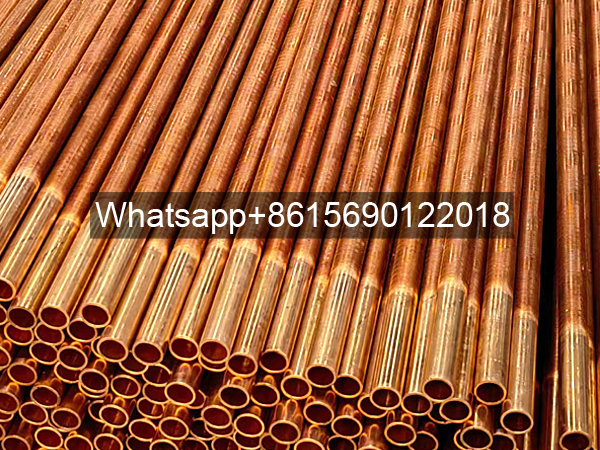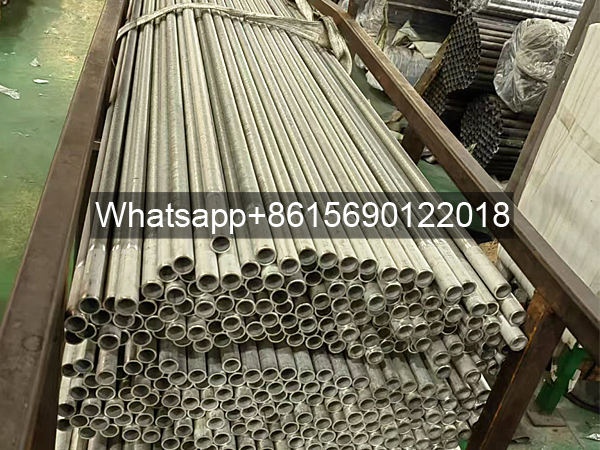3/4 Fin Tube Low Fin

3/4 Fin Tube Low Fin is a type of low-finned tube. It is an enhanced heat transfer element with low-profile, closely spaced fins formed on the outer surface of a base tube through a mechanical rolling or rolling process. Its core features are a fin height typically ≤3mm, a fin pitch of 2-5mm, and a fin ratio (fin ratio) of 2-3. It achieves efficient heat transfer by expanding the heat transfer area and turbulent airflow.
3/4 Fin Tube Low Fin Features:
I. 3/4 Fin Tube Low Fin Manufacturing Process
Rolling Method: Plain tubes are directly processed into low-fin tubes through three-roll cross-rolling at room temperature. The fins and base tube are integrally formed, eliminating contact thermal resistance. Daily production can reach 15,000 meters.
Sleeveless Process: Aluminum fins are stamped and then sleeved onto copper tubes, achieving close contact through expansion. Suitable for Freon refrigeration equipment.
II. 3/4 Fin Tube Low Fin Structural Parameters
Fin Height: 1.2-3mm (For example, copper tubes for Freon refrigeration have fin heights of 1.2-2mm, while steel tubes for ammonia refrigeration have fin heights of up to 3mm).
Fin Spacing: 2-5mm (Excessively large reduces heat transfer efficiency, while excessively small increases dust accumulation).
Base Tube Material: Copper (T2 copper), stainless steel (304/316), carbon steel, or titanium alloy, selected based on operating conditions.
III. 3/4 Fin Tube Low Fin Performance Advantages
Heat Transfer Enhancement: Fins strip away the fluidized bed, increasing the heat transfer coefficient by over 30%, increasing the heat transfer area by 2-3 times with the same metal usage.
Self-Cleaning Function: Thermal expansion and contraction inhibit fouling, resulting in superior anti-fouling performance compared to bare tubes.
Low-Drag Design: Recommended airflow velocity is 1.5-3.5m/s, and the tube center-to-center spacing is 54-67mm (adjusted based on fin height).


IV. Typical Applications of 3/4 Fin Tube Low Fin
Refrigeration Equipment: Freon evaporators and condensers (copper tube + aluminum fin combination).
Industrial Heat Exchange: Oil coolers and waste heat boilers (carbon steel/stainless steel)
Special Applications: Titanium alloy low-fin tubes are used in highly corrosive environments (such as chemical and marine engineering).
V. 3/4 Fin Tube Low Fin Selection Recommendations
Corrosive Media: 316 stainless steel or titanium tubes are preferred.
Low-Temperature Refrigeration: Threaded copper tubes (fin pitch 3.5-10mm) are preferred.
High-Dust Environments: H-Type Low-Fin Tubes can reduce dust accumulation.
Advantages of Low-Fin Tubes over Bare Tubes
1. Improved Heat Transfer Efficiency
Increased Heat Transfer Area: Fins are machined onto the outer surface of the bare tube through a mechanical rolling process, resulting in a heat transfer area (rib coefficient) of 2-3 times that of a bare tube. For example, a 50mm diameter bare tube has a surface area of 0.16㎡ per meter, while a low-fin tube can increase this to 0.8-1.6㎡.
Enhanced convective heat transfer: The fin structure disrupts the fluid boundary layer, creating turbulence, which increases the air-side heat transfer coefficient by 30%-50%. In condensation heat transfer, the heat transfer coefficient of low-fin tubes is 75%-100% higher than that of bare tubes.
2. Energy Saving and Space Optimization
Significant energy savings: Under the same heat load, low-fin tubes can reduce the required heat transfer area by 30%, lowering energy consumption. For example, using finned tubes in boiler systems can reduce exhaust gas temperatures by 40-60°C and improve thermal efficiency by 0.5%/10°C.
Compact structure: Enhanced heat transfer capacity per unit volume results in a smaller device, making it easier to deploy in limited spaces.
3. Anti-fouling and Self-cleaning Capabilities
Reduces fouling: The thermal expansion and contraction of the fins causes hard scale to break off at the fin roots, reducing maintenance frequency.
Adapts to Complex Operating Conditions: The staggered tube bundle design further reduces heat exchange area requirements by 30%, making it particularly suitable for condensing oil-based fluids.
4. Material and Process Advantages
Various Materials: The base tube can be made of stainless steel, steel, titanium, and other materials, and the fin thickness can be flexibly adjusted (0.3-1mm), balancing cost and performance.
Proven Process: The three-roll cross-rolling method creates an integral structure between the fins and the base tube, eliminating contact thermal resistance issues.
Limitations
Not suitable for fluids prone to fouling: Highly viscous or easily coking media may affect fluid flow between the fins.
High flow resistance: Too small fin spacing increases pressure drop, balancing heat transfer efficiency and energy consumption.
Low-fin tubes offer significant advantages in terms of efficient heat transfer, energy savings, and space utilization by expanding the heat transfer area and optimizing fluid dynamics. However, appropriate parameters must be selected based on specific operating conditions.
3/4 Fin Tube Low Fin Materials
The material selection for low-fin tubes should be based on the temperature resistance, corrosion resistance, and cost requirements of the specific application. The following are mainstream materials and their characteristics:
1. Copper Low-Fin Tubes
Properties: Excellent thermal conductivity (thermal conductivity coefficient approximately 398 W/(m·K)), strong corrosion resistance, and suitable for high-temperature and high-humidity environments.
Applications: Primarily used in high-efficiency heat exchange applications such as air conditioning condensers, evaporators, and nuclear power plant heat exchangers.
Disadvantages: High cost and difficult to process.
2. Low-Fin Tubes Made of Stainless Steel
Common Models:
304 Stainless Steel: Resistant to weak acids and alkalis, operating temperatures ≤ 400°C, with a thermal conductivity of approximately 16.3 W/(m·K), suitable for residential HVAC and general industrial applications.
316L Stainless Steel: Molybdenum-added for enhanced resistance to chloride ion corrosion, with a temperature resistance of up to 450°C, suitable for highly corrosive environments such as chemical and marine engineering.
Advantages: Long lifespan (12-15 years), low maintenance costs.
3. Low-Fin Tubes Made of Carbon Steel
Features: Good thermal conductivity (approximately 45 W/(m·K)), low cost, but requires corrosion protection (such as galvanizing).
Applications: Suitable for medium- and low-temperature, low-corrosion environments (such as coal-fired boilers and heating systems). Typical service life: 5-8 years.
4. Other Materials
Aluminum: Lightweight and good thermal conductivity, but poor temperature resistance (<300°C), mostly used in lightweight heat exchange equipment.
Duplex steel/titanium tubes: Used in specialized applications, such as highly corrosive or extreme temperature environments.

